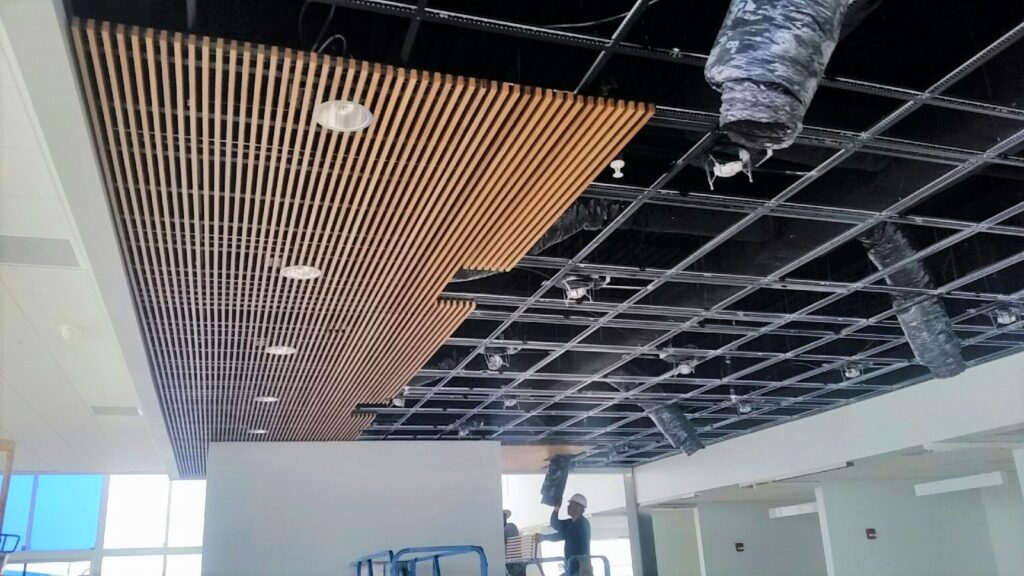There are a few things you should consider before choosing the type of ceiling you want in your house. For instance, a drop ceiling offers practical advantages over a drywall ceiling.

Cost
Suspended ceilings are a popular choice for commercial interiors, but they can also be used in residential homes. They offer a sleek, modern appearance and hide any unsightly pipes or electrical wiring that might otherwise be exposed. They can also be used to cover stains and other imperfections on the existing ceiling. If you’re thinking about installing a suspended ceiling, it’s important to consider all of the costs involved. This includes the cost of supplies, labor, and long-term energy costs.
The cost of a dropped ceiling can vary widely depending on the type and material of tiles and the size of the room. For example, acoustic ceiling tile (ACT) systems typically cost between PS26-PS62 per square meter for supply and installation. However, the cost can be higher if you install additional acoustic accessories like grid rail covers and decorative tegular panels. ACT tiles are available in a variety of colors and finishes, so you can find a solution that fits your space.
When hiring a contractor for a new drop ceiling, make sure to ask about their experience and past projects. This will help you avoid any surprises down the road. You can also look for recommendations from friends and family members. Alternatively, you can use HouseholdQuotes to search for and compare quotes from experienced professionals.
The initial cost of a dropped ceiling can be more expensive than drywall, but the long-term cost savings outweigh the initial investment. According to a five-city study by the Center for Incentive and Sustainable Construction (CISCA), dropped ceilings can save up to 10.3 percent of energy costs in offices.
Unlike drywall, which is attached to the existing structural ceiling, dropped ceilings are hung from brackets fixed to the underside of the roof or slab. The brackets support a series of interlocking metal sections that form a grid or beam system into which ceiling panels can be fitted. These panels can then be removed to access wires, ductwork, and pipes above them.
In some cases, it may be necessary to obtain a permit to install a suspended ceiling. This can add up to $400 to the total cost of the project. Fortunately, most professional contractors will include the cost of permits in their original quote and take care of all paperwork for you.
Maintenance
Whether you have drywall ceilings or drop ceilings in your home, they require regular maintenance. A drop ceiling will need to be inspected regularly to ensure the framework is secure. It’s also important to check for sagging or discoloration. If you notice any of these issues, it’s essential to remove the panels and replace them with new ones.
A suspended ceiling offers numerous advantages that make it a practical option for most homeowners. For instance, it allows you to hide unsightly pipes and air vents. This gives the space a cleaner look. You can also use this space to run wiring, cables, and other utilities. With a drop ceiling, you can easily access these systems when needed without having to tear apart the entire ceiling.
One of the biggest drawbacks of a suspended ceiling is that it takes up more space than a drywall ceiling. It also requires more manpower during installation, since drywall sheets need to be secured to the ceiling beams. However, once the drywall is installed, it’s easy to maintain and add decorative elements.
Another benefit of a drop ceiling is that it provides insulation and reduces the amount of space being heated or cooled, which can help cut down on energy bills. It can also provide an acoustic barrier against external noises. In addition, it can conceal building defects or issues that may need to be addressed, such as a leaky roof or structural problems.
Both options can be easily adapted to your unique needs and preferences. For example, a drywall ceiling can be painted or covered with acoustic tiles. Acoustical tiles are made of soft absorbent material filled with small holes, which helps to diffuse sound and create a more comfortable environment.
In addition, a suspended ceiling is much easier to install in a basement than a drywall ceiling. Since drywall must be attached directly to the ceiling beams, you lose more headroom than with a suspended ceiling. Lastly, a drywall ceiling is not as visually appealing as a drop ceiling. However, it’s still an affordable option for most homeowners and is easy to maintain.